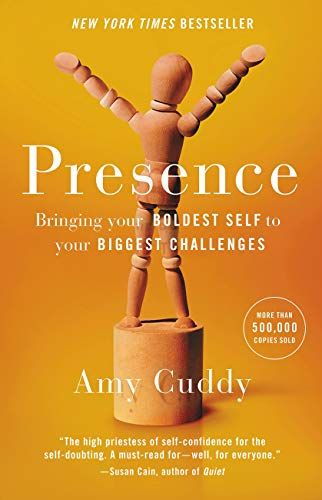Presence: Bringing Your Boldest Self to Your Biggest Challenges – Amy Cuddy

Presence: Bringing Your Boldest Self to Your Biggest Challenges by Amy Cuddy explores how we can embody confidence and bring our authentic selves to any situation we face. The book provides actionable techniques for overcoming the fear of being judged and reveals how our body language, mindset, and behavior can impact our life and success. Here are 10 key insights derived from the book:
The Power Pose
The practice of power posing involves standing or sitting in a confident position for a few minutes.
It can help to decrease cortisol levels, reduce stress, and increase testosterone levels.
By doing this, you can enhance your overall presence and make a lasting impact in high-pressure situations.
Overcoming Impostor Syndrome
Many people experience impostor syndrome, or the feeling of not belonging or being worthy.
Recognize that these feelings are common amongst high achievers and that everyone experiences self-doubt.
Embrace your uniqueness and be open to learning from mistakes and feedback, ultimately fostering personal growth.
The Role of Vulnerability
Being authentic often means being vulnerable, as vulnerability promotes genuine connection.
Embrace your perceived flaws and share your genuine emotions and experiences.
Acknowledging vulnerability can empower others, build trust and strengthen relationships.
The Importance of Empathy
Demonstrating empathy can not only improve relationships but also increase your presence.
Tuning into others’ emotions and perspectives allows you to connect on a deeper level.
By understanding and validating their experiences, you can be more effective in communication and problem-solving.
Tuning into Your Body
Connecting with your body helps cultivate presence.
Practice deep breathing and mindfulness exercises to calm your nervous system and stay grounded.
Allow your body to express confidence through open and expansive body postures, leading to increased feelings of self-assuredness and presence.
Embodying Presence
Being present involves both your mental state and physicality.
Aligning your thoughts, feelings, and body language can create a harmonious sense of authenticity.
Mindfully attending to your body posture, facial expressions, and gestures can convey presence, helping to build trust and connection with others.
Believing Your Story
To communicate with confidence, you must believe in your own message.
Develop a narrative that resonates with your values and experiences.
Once you feel connected to your story, it becomes more natural to express it authentically and convincingly, leading to stronger presence in any situation.
Preparing for Challenges
Planning helps you navigate challenging situations with confidence.
Break down tasks into achievable goals, practice active listening and self-awareness, and reflect on past achievements to boost your confidence.
The more prepared you are for challenges, the more likely you are to exhibit presence in these situations.
Nonverbal Cues
Our nonverbal communication may have more impact than the words we say.
Focusing on eye contact, touch, tone of voice, and posture can foster a sense of trust and credibility.
Being aware of these cues can enhance your communication skills and help you connect more effectively with others.
Managing Self-Doubt
Self-doubt can hinder our ability to be present.
To overcome this, be compassionate toward yourself, focus on your values, and visualize positive outcomes in challenging situations.
Recognize that attempting to hide insecurity may only fuel it, so be honest with yourself and others.

